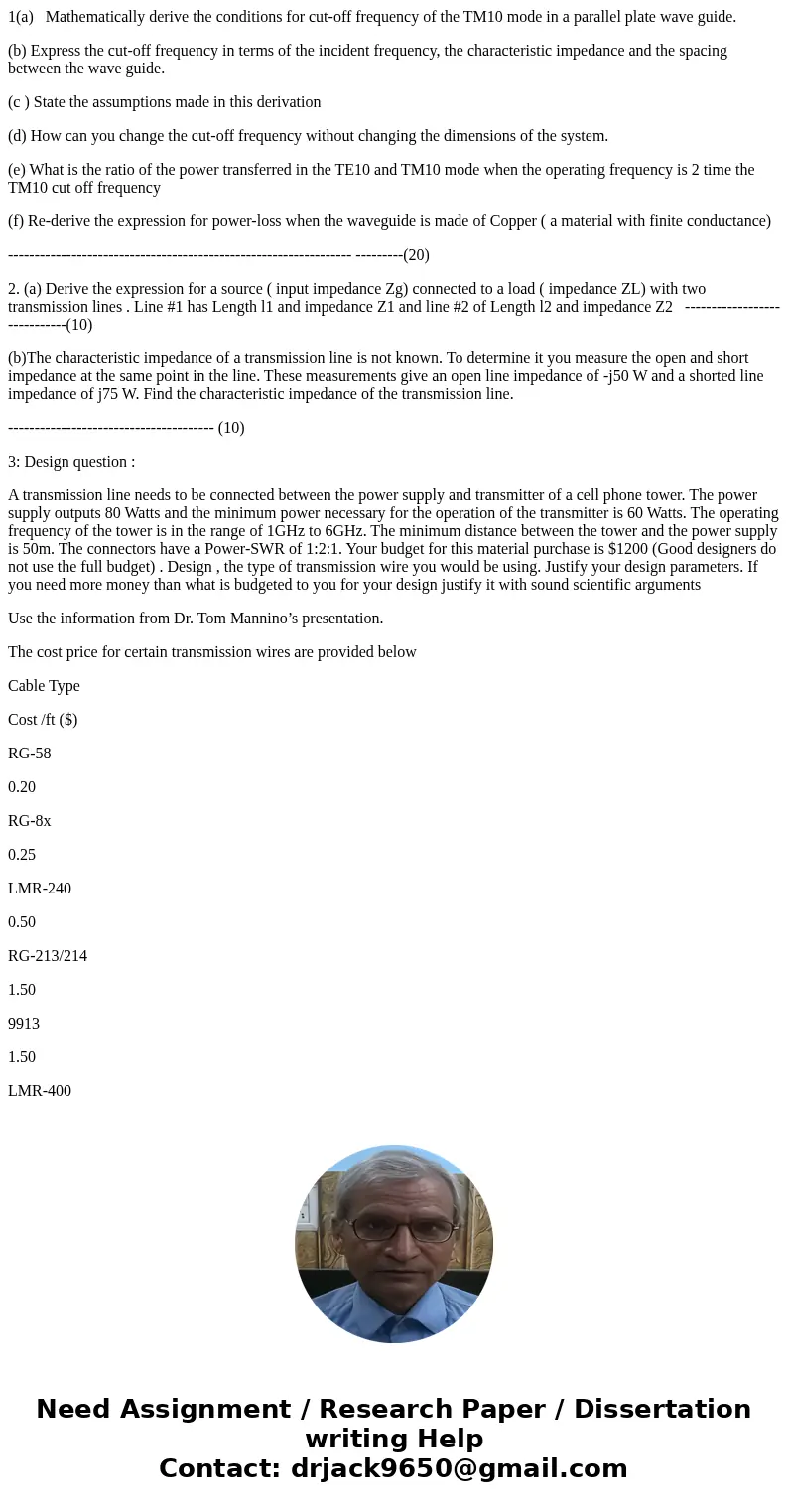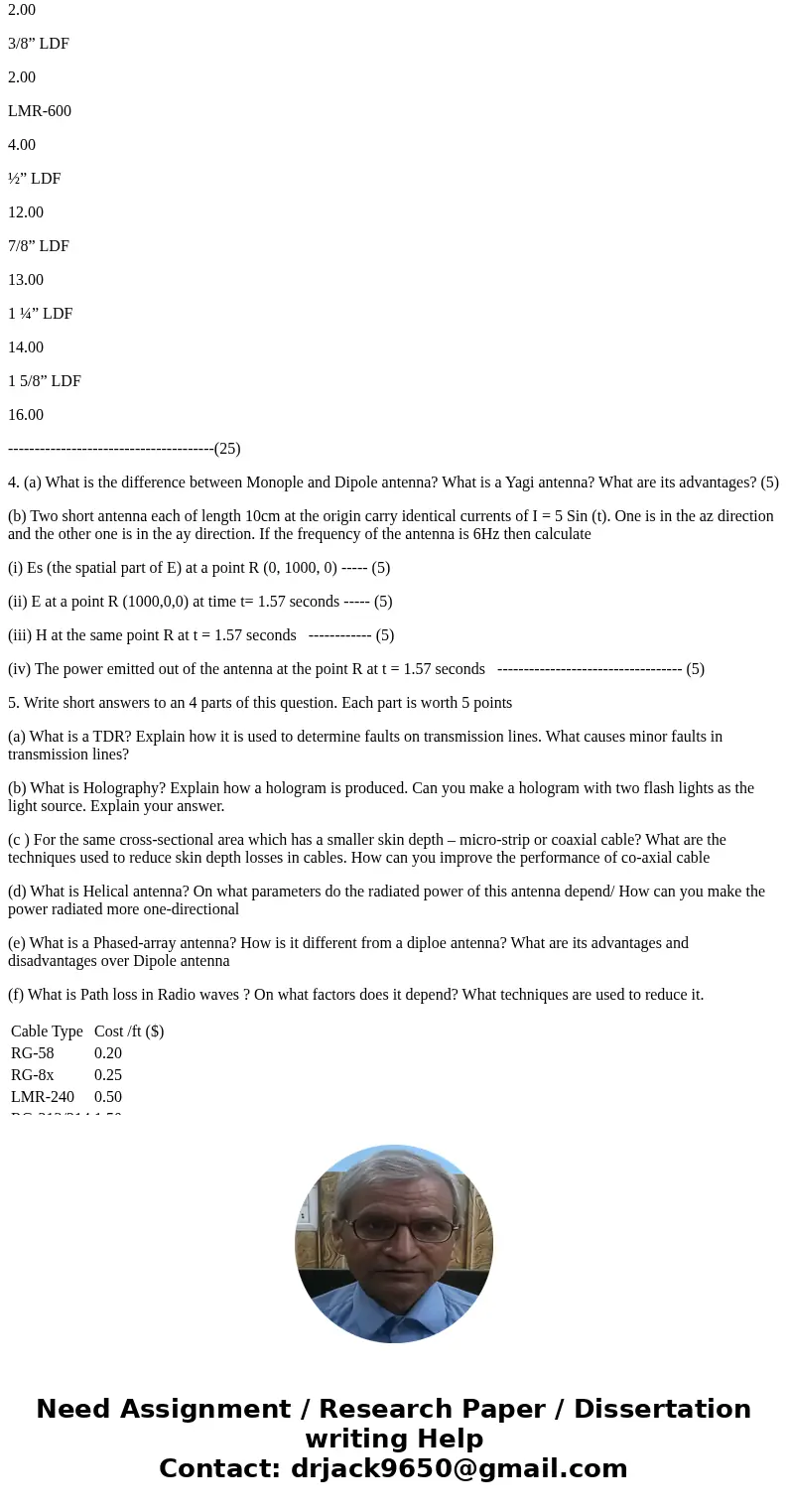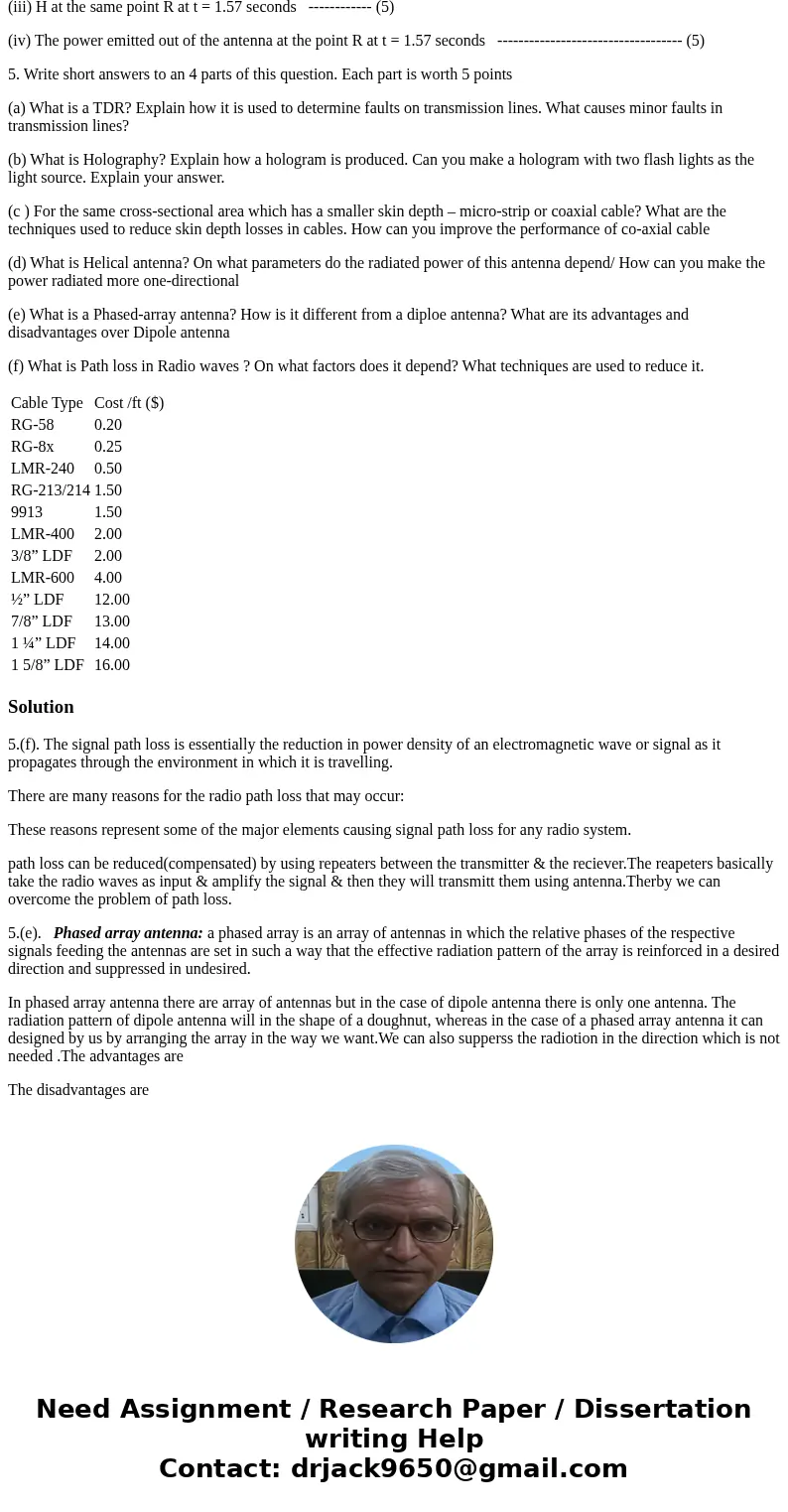1a Mathematically derive the conditions for cutoff frequency
1(a) Mathematically derive the conditions for cut-off frequency of the TM10 mode in a parallel plate wave guide.
(b) Express the cut-off frequency in terms of the incident frequency, the characteristic impedance and the spacing between the wave guide.
(c ) State the assumptions made in this derivation
(d) How can you change the cut-off frequency without changing the dimensions of the system.
(e) What is the ratio of the power transferred in the TE10 and TM10 mode when the operating frequency is 2 time the TM10 cut off frequency
(f) Re-derive the expression for power-loss when the waveguide is made of Copper ( a material with finite conductance)
----------------------------------------------------------------- ---------(20)
2. (a) Derive the expression for a source ( input impedance Zg) connected to a load ( impedance ZL) with two transmission lines . Line #1 has Length l1 and impedance Z1 and line #2 of Length l2 and impedance Z2 -----------------------------(10)
(b)The characteristic impedance of a transmission line is not known. To determine it you measure the open and short impedance at the same point in the line. These measurements give an open line impedance of -j50 W and a shorted line impedance of j75 W. Find the characteristic impedance of the transmission line.
--------------------------------------- (10)
3: Design question :
A transmission line needs to be connected between the power supply and transmitter of a cell phone tower. The power supply outputs 80 Watts and the minimum power necessary for the operation of the transmitter is 60 Watts. The operating frequency of the tower is in the range of 1GHz to 6GHz. The minimum distance between the tower and the power supply is 50m. The connectors have a Power-SWR of 1:2:1. Your budget for this material purchase is $1200 (Good designers do not use the full budget) . Design , the type of transmission wire you would be using. Justify your design parameters. If you need more money than what is budgeted to you for your design justify it with sound scientific arguments
Use the information from Dr. Tom Mannino’s presentation.
The cost price for certain transmission wires are provided below
Cable Type
Cost /ft ($)
RG-58
0.20
RG-8x
0.25
LMR-240
0.50
RG-213/214
1.50
9913
1.50
LMR-400
2.00
3/8” LDF
2.00
LMR-600
4.00
½” LDF
12.00
7/8” LDF
13.00
1 ¼” LDF
14.00
1 5/8” LDF
16.00
---------------------------------------(25)
4. (a) What is the difference between Monople and Dipole antenna? What is a Yagi antenna? What are its advantages? (5)
(b) Two short antenna each of length 10cm at the origin carry identical currents of I = 5 Sin (t). One is in the az direction and the other one is in the ay direction. If the frequency of the antenna is 6Hz then calculate
(i) Es (the spatial part of E) at a point R (0, 1000, 0) ----- (5)
(ii) E at a point R (1000,0,0) at time t= 1.57 seconds ----- (5)
(iii) H at the same point R at t = 1.57 seconds ------------ (5)
(iv) The power emitted out of the antenna at the point R at t = 1.57 seconds ----------------------------------- (5)
5. Write short answers to an 4 parts of this question. Each part is worth 5 points
(a) What is a TDR? Explain how it is used to determine faults on transmission lines. What causes minor faults in transmission lines?
(b) What is Holography? Explain how a hologram is produced. Can you make a hologram with two flash lights as the light source. Explain your answer.
(c ) For the same cross-sectional area which has a smaller skin depth – micro-strip or coaxial cable? What are the techniques used to reduce skin depth losses in cables. How can you improve the performance of co-axial cable
(d) What is Helical antenna? On what parameters do the radiated power of this antenna depend/ How can you make the power radiated more one-directional
(e) What is a Phased-array antenna? How is it different from a diploe antenna? What are its advantages and disadvantages over Dipole antenna
(f) What is Path loss in Radio waves ? On what factors does it depend? What techniques are used to reduce it.
| Cable Type | Cost /ft ($) |
| RG-58 | 0.20 |
| RG-8x | 0.25 |
| LMR-240 | 0.50 |
| RG-213/214 | 1.50 |
| 9913 | 1.50 |
| LMR-400 | 2.00 |
| 3/8” LDF | 2.00 |
| LMR-600 | 4.00 |
| ½” LDF | 12.00 |
| 7/8” LDF | 13.00 |
| 1 ¼” LDF | 14.00 |
| 1 5/8” LDF | 16.00 |
Solution
5.(f). The signal path loss is essentially the reduction in power density of an electromagnetic wave or signal as it propagates through the environment in which it is travelling.
There are many reasons for the radio path loss that may occur:
These reasons represent some of the major elements causing signal path loss for any radio system.
path loss can be reduced(compensated) by using repeaters between the transmitter & the reciever.The reapeters basically take the radio waves as input & amplify the signal & then they will transmitt them using antenna.Therby we can overcome the problem of path loss.
5.(e). Phased array antenna: a phased array is an array of antennas in which the relative phases of the respective signals feeding the antennas are set in such a way that the effective radiation pattern of the array is reinforced in a desired direction and suppressed in undesired.
In phased array antenna there are array of antennas but in the case of dipole antenna there is only one antenna. The radiation pattern of dipole antenna will in the shape of a doughnut, whereas in the case of a phased array antenna it can designed by us by arranging the array in the way we want.We can also supperss the radiotion in the direction which is not needed .The advantages are
The disadvantages are



 Homework Sourse
Homework Sourse